What is a bow echo, how did it signal Delhi’s fierce storm?
A bow echo is a radar signature of a high wind-driven storm front which forms due to strong winds pushing the centre of the storm line forward, indicating intense straight-line winds.
 A car and a bus were seen almost entirely underwater at an underpass in Delhi Cantonment on Sunday Morning after the heavy rain in Delhi NCR. (Express Photo - Gajendra Yadav)
A car and a bus were seen almost entirely underwater at an underpass in Delhi Cantonment on Sunday Morning after the heavy rain in Delhi NCR. (Express Photo - Gajendra Yadav)The intense storm that hit Delhi on Sunday appeared in an unusual shape in the India Meteorological Department’s (IMD’s) weather radar imagery. The storm looked like a crescent or an archer’s bow. In technical terms, such presentations of storms are called “bow echoes”.
Meteorologists track bow echoes because they are often a precursor to more destructive windstorms. For instance, during the Sunday storm, Delhi witnessed winds reaching up to 100 kmph.
What exactly is a ‘bow echo’?
A bow echo is essentially a line of storms, also called a squall line, on the radar that looks like a bow. Note that this squall line can sometimes be embedded in a larger squall line.
 Bow echo.
Bow echo.
A bow echo can extend from 20 km to 100 km, and last between three and six hours.
The term was coined in the 1970s by Ted Fujita, a Japanese American meteorologist known for developing the scale to classify tornadoes.
How does a bow echo form?
When rain-cooled air comes down to the ground, and spreads out horizontally. As this happens, a boundary called the gust front is created between the rain-cooled air and warm-moist air on the surface.
This front pushes up the warm-moist air into the atmosphere, which forms new thunderstorms. These new thunderstorms produce more rain, thereby creating more rain-cooled air, which helps the gust front to maintain its strength.
As this process keeps repeating itself, there comes a point when there is an inflow of air on the trailing side of the line of storms and bends it like an archer’s bow. The cycle lasts as long as new thunderstorms keep forming at the front, helping the system grow and move forward with strong winds.
Umasankar Das, a senior scientist with the IMD, told The Indian Express, “Bow echoes are often associated with severe weather, including damaging straight-line winds”.
Have bow echoes formed previously in India?
Bow echoes are not a new phenomenon. On May 31, 2022, a bow echo was formed over Delhi and Noida. However, it was short-lived, lasting for an hour, and produced winds of up to 100 kmph.
“…Such a squall line was observed during thunderstorm activity in Odisha too, this month”, said Rahul Saxena, senior IMD scientist. He added that these have appeared often in India during intense thunderstorms.
- 01
- 02
- 03
- 04
- 05






































